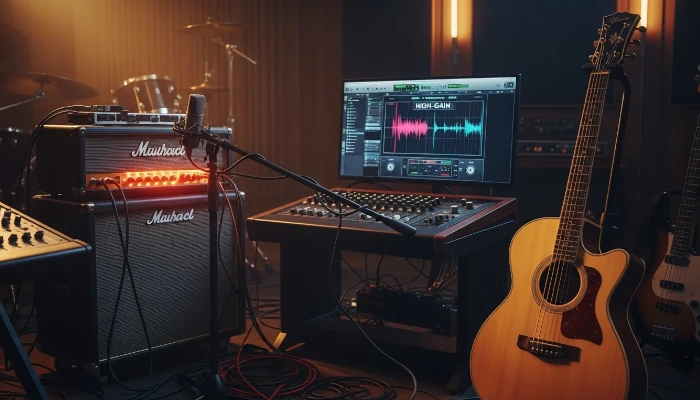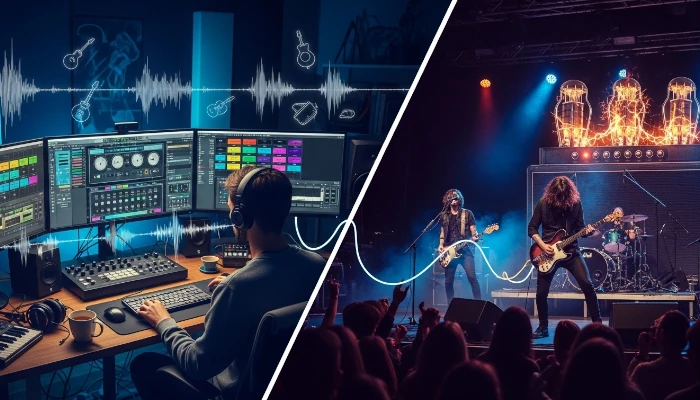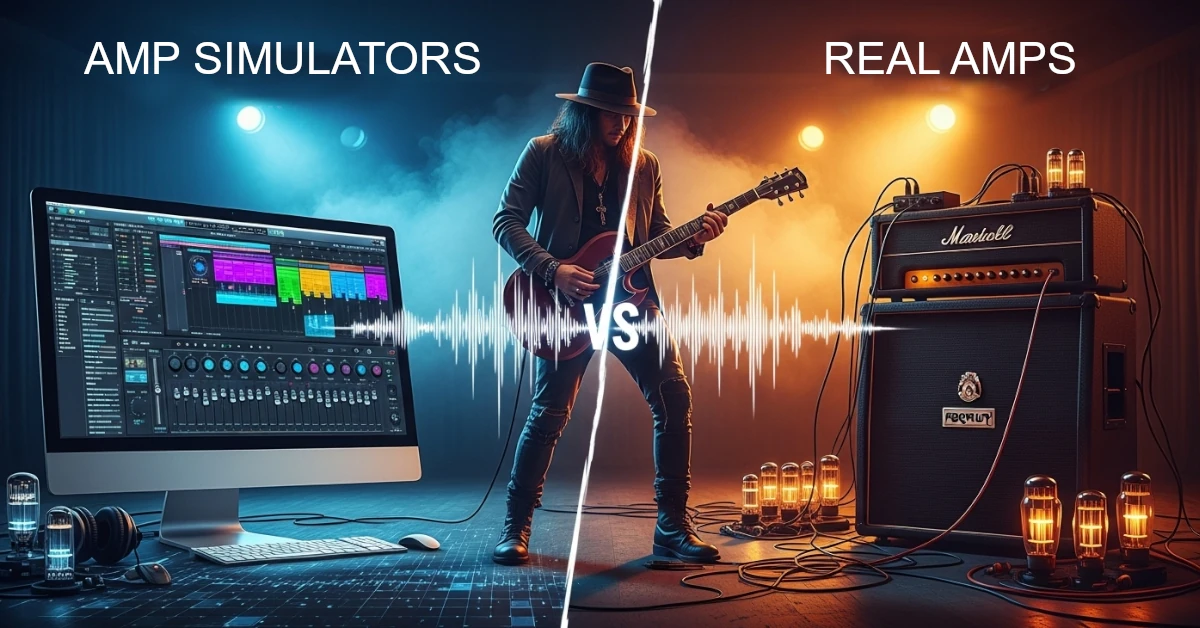Struggling to decide between the convenience of amp sims and the raw power of real amps? You’re not alone! This article breaks down the ultimate amp showdown to help you choose the best tool for your sound. First, we’ll explore the pros and cons of amp sims for today’s guitarists, highlighting their flexibility and cost-effectiveness. Then, we’ll dive into the world of real amps, discussing the unique tone, feel, and live experience they offer. Next up, we’ll put them head-to-head with a sound comparison, including audio examples to showcase the nuances. Finally, we’ll provide practical guidance on when to use amp sims vs. real amps, helping you make the right choice for any situation.
Amp Sims: The Pros and Cons for Modern Guitarists
Amp simulation software (or amp sims) has become a huge part of the modern guitarist’s toolkit, offering a different path compared to traditional tube or solid-state amplifiers. They essentially mimic the sound and feel of famous amps, cabinets, and effects inside your computer. For anyone building a home studio or just wanting more flexibility, understanding the trade-offs when Using Amp Sims vs Real Amps is key.
The biggest ‘pro’ is convenience. You can access hundreds of classic and modern amp sounds without needing the physical gear, saving massive amounts of space and money. Recording is often simpler too – no mic placement headaches, just plug your guitar into an audio interface. This is especially handy if you live in an apartment and can’t crank a real amp. You can record silently using headphones anytime, day or night. They also offer incredible flexibility for tweaking and re-amping later.
On the ‘con’ side, some players feel amp sims lack the physical “feel” and dynamic response of a loud tube amp moving air. Getting a great tone can sometimes involve a steeper learning curve than just plugging into a good amp. You also need a reliable computer and audio interface, and latency issues can sometimes be a problem if your setup isn’t optimized. While the sounds are amazing, they are digital emulations, and some purists argue you lose a certain organic quality.

Example: Think of Sarah, a guitarist trying to record an album in her small apartment. Buying and miking multiple amps for different tones (clean pop, crunchy rock, heavy metal) is impossible financially and logistically. Using amp sims, she can access all those sounds instantly, record silently at 1 AM, and even change the “amp” or “mic” after recording the guitar part if she changes her mind. This practical application saves her time, money, and her relationship with her neighbors.
Practical Tip: Don’t just rely on factory presets. Dive into the settings! Experiment with different virtual cabinets and microphone placements within the sim. Often, swapping the cabinet simulation makes a bigger difference to the overall tone than changing the amp head.
Real Amps: Exploring Tone, Feel, and the Live Experience
While amp simulations offer incredible convenience, there’s a reason traditional real amps – tube or solid-state – remain the go-to for many guitarists. When considering Using Amp Sims vs Real Amps, the physical amp brings a different kind of magic, especially regarding dynamic response, feel, and the live performance environment.
The core appeal of a real amp is often the tangible interaction. A tube amp, in particular, reacts dynamically to your playing touch in a way many find uniquely inspiring. The speaker cabinet itself is a crucial part of the sound, moving air and interacting with the room, adding a physical dimension. For live players, having a real amp on stage provides reliable monitoring, stage presence, and a direct, often simpler signal chain than complex digital rigs. There’s also just that visceral thrill of a great amp sound filling the space.
However, the trade-offs are significant. Real amps can be expensive, heavy, and require maintenance. Achieving their best tones often means playing at volumes impractical for home recording or small gigs. Miking a real amp for recording requires specific gear, acoustic considerations, and skill – it’s not just plug-and-play like an amp sim. They also offer less versatility unless you own multiple amps covering different styles.

Example: Think of Maria, a guitarist playing in a rock band. For her, the sound of her cranked tube amp pushing air on stage is integral to the band’s energy. She relies on the amp’s natural compression and feedback characteristics, using her guitar’s volume knob to switch between clean and overdriven tones. This dynamic interaction is crucial for her stage performance, providing a connection with the sound that feels essential for engaging a live audience.
Practical Tip: If you’re recording a real amp at home but can’t crank it, experiment with mic placement even at lower volumes. Small adjustments in distance from the speaker cone or angle can drastically change the tone. Even a low-wattage amp recorded well can sound huge!
Amp Sims vs. Real Amps: A Sound Comparison (With Audio Examples)
When you get down to Using Amp Sims vs Real Amps, the core question often boils down to: how do they sound different? On paper, amp sims aim to perfectly replicate the sound of a miked amplifier. And modern sims get incredibly close, capturing the EQ curve, distortion characteristics, and even the subtle compression and harmonic richness. In a dense mix, it can be genuinely difficult for listeners to tell the difference between a high-quality sim and a real amp recording.
However, many players feel there’s a difference in the feel and the subtle dynamic response that translates into sound, especially when playing solo or in simpler arrangements. Real amps, particularly tube amps, react uniquely to picking dynamics – hit harder and you get more grit and harmonic bloom. The speaker cabinet also plays a huge role, moving air and interacting with the room in a way a digital model has to emulate. While sims are getting better at this, some argue they can sometimes feel a little “flat” or lack that organic “give” and subtle feedback a physical amp provides.
Ultimately, the “better” sound is subjective and depends heavily on the context and your personal preference. Comparing them side-by-side (ideally with audio examples!) is the best way to hear these nuances for yourself.

Example: Imagine tracking a rhythm guitar part for a busy metal track. The raw, aggressive tone is key. Both a real high-gain amp miked up and a modern high-gain amp sim can provide a crushing sound that sits perfectly in the mix alongside drums and bass. The subtle dynamic differences might get lost. Now, imagine recording a clean, fingerpicked acoustic-electric passage. Here, the subtle harmonic detail and dynamic sensitivity might make the nuances of a real amp’s preamplifier and speaker interaction more noticeable compared to a sim.
Practical Tip: When comparing, use the same guitar and try to match the gain and EQ settings as closely as possible. Pay close attention to how the sound responds when you vary your picking attack from soft to hard. Listen not just to the distortion, but the subtle harmonics and sustain.
When to Use Amp Sims vs. Real Amps: Choosing the Right Tool for the Job
Okay, so we’ve talked about the pros and cons of Using Amp Sims vs Real Amps and how they sound. But the real question isn’t which one is “better” overall, it’s which one is the right tool for what you’re trying to do right now? Thinking this way makes the decision much easier.
Amp sims are often the champions of convenience, flexibility, and silent operation. If you’re recording demos late at night in an apartment, need access to a huge range of tones without buying tons of gear, or want the ability to radically change your guitar sound after you’ve recorded it (that’s called re-amping!), sims are your best friend. They’re also fantastic for practicing with headphones or building complex guitar sounds with lots of virtual effects.
Real amps, on the other hand, often excel where physical presence, raw power, and tactile feel are paramount. For live performances, a real amp provides stage volume, monitoring, and that undeniable connection to your sound pushing air. In a professional studio with a great sounding room and skilled engineers, miking a killer amp can capture a depth and dynamic response that some players still prefer. If your core sound is a specific amp that you love interacting with physically, playing through the real thing might be more inspiring.

Example: Imagine you’re producing a complex pop track with layers of clean, jangly guitars, a few distorted riffs, and maybe some ambient swells. Instead of needing multiple amps and mic setups, an amp sim suite lets you dial in all those sounds quickly from your computer, record them silently, and easily tweak them later in the mix. Now, picture yourself playing a high-energy rock gig. You rely on your amp’s feedback and dynamic breakup for your stage presence and interaction with the band. A real amp is likely the essential tool here.
Practical Tip: Don’t be afraid to use both! Many producers and guitarists use amp sims for certain tracks (like clean rhythm or layered parts) and real amps for others (like lead lines or main riffs). Evaluate your current need: recording silently? Maximum tone options? Live performance? The situation dictates the best tool.
Amp Sims vs. Real Amps: Finding the Right Sound for You
Ultimately, the choice between amp sims and real amps hinges on your specific needs. Amp sims offer unparalleled convenience, flexibility, and silent recording capabilities, making them ideal for home studios and diverse tonal palettes. Real amps, on the other hand, deliver the raw power, dynamic feel, and stage presence that many guitarists crave for live performances and capturing that authentic amp-in-a-room sound. By understanding the strengths of each, you can make informed decisions and assemble the perfect guitar rig for any situation.
Now, go experiment and discover which setup inspires your best playing!

